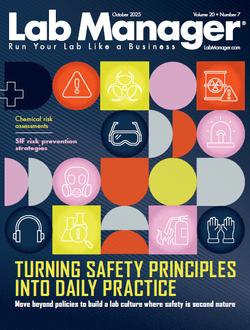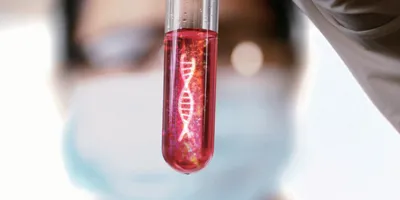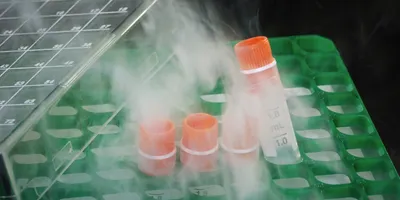Science and research are advancing by the day, and Texas Tech University is well aware of it. The Lubbock-based institution opened its first Experimental Sciences Building—a 127,810 sq. ft. facility with 50,851 sq. ft. of lab space—in 2006, and soon made plans for a second research facility. Experimental Sciences Building II, also known as ESBII, broke ground in February 2017 and opened with a ribbon-cutting ceremony on Oct. 3, 2019.
The $77-million ESBII was designed by TreanorHL architects, with exterior façade and interior finish design by AyersSaintGross. The project’s landscape architect, Prairie Workshop LLC, has previously worked on a number of other Texas Tech projects, including Jones AT&T Stadium, the National Ranching Heritage Center, and the Texas Tech University Health Sciences Center Memorial Garden. Flintco, LLC, completed the construction of the facility and grounds. The building measures 117,800 gross square feet.
 Texas Tech's Experimental Science Building II in Lubbock.CREDIT: TEXAS TECH
Texas Tech's Experimental Science Building II in Lubbock.CREDIT: TEXAS TECH
Dr. Joseph Heppert, Vice President for Research & Innovation at Texas Tech University, acknowledges that the college’s aging facilities present the need for more modern labs so that researchers can keep pace with new technology and scientific discoveries.
“There's been a recognition on the campus that we need to expand research space to meet the increasing needs of researchers on the campus,” he says. “Many scientific buildings are 50 or 60 years old. It's not that they’re reaching the end of their life as buildings, but we’re doing things in them that were never anticipated when these buildings were first built.”
Heppert says that current research is outpacing the physical characteristics and capabilities of Texas Tech buildings that were constructed a long time ago, hence the need for new facilities such as ESBII. Buildings such as this have been upgraded in order to support new research and new research themes.
Sustainability and flexibility
Sustainability initiatives are part of the plan in ESBII. Small details, such as water bottle filling stations and water sensors in restrooms, play a role in making the building greener, as do larger features such as lighting and ventilation systems.
“We consciously designed the building to accommodate multidisciplinary research but also to be frugal with respect to utilities. We’ve gone to very efficient lighting throughout the buildings,” says Heppert. “We've incorporated technologies for modulating the flow of ventilation, particularly in chemical science laboratories. If we either have laboratory occupancy by researchers or we have sensors that sense there's heavy chemical utilization in the hoods, there’s obviously increased air flow in those situations.”
Heppert adds that a crucial need for new science and technology buildings is that the facilities need to be easily and readily configured to meet the needs of future researchers, as well as the changing needs of current researchers. ESBII incorporates features such as non-fixed utilities, where all the benches are detachable and moveable, and all the utilities come from above.
“One of the key themes was we wanted this build to be able to be reconfigurable over a long lifetime,” says Heppert. He adds that the planning team was also intent on keeping the personnel spaces separate from the laboratory spaces, while still providing good light as well as good visibility into the labs.
 Biological intensive laboratories in ESBII.CREDIT: TEXAS TECH
Biological intensive laboratories in ESBII.CREDIT: TEXAS TECH
The labs are designed as “a kind of classical computation space,” Heppert notes, with ample room for centrifuges, growth chambers, and minus 80 freezers. There are conference rooms of various sizes, and spaces outside the office areas where teams can spread out and work. Eating spaces are designed to promote interaction.
Advanced Lab Management Certificate
The Advanced Lab Management certificate is more than training—it’s a professional advantage.
Gain critical skills and IACET-approved CEUs that make a measurable difference.
“Even right outside some of the labs, we’ve got people to sit down and write up results or work together to analyze results, and then go back in the lab and continue their work,” says Heppert.
The importance of collaboration
The thought behind the initial ESBI building, says Heppert, was to create a non-college based, non-siloed area for researchers to collaborate. ESBII follows the same model. While there is a wide range of activity that will occur in the building, the plan reflects a desire to group common thematic studies together in areas where they can collaborate.
“We’re going to have chemists, biologists, medicinal chemists, and individuals who are working in aspects of human biology and disease biology, as well as individuals who are working in population genomics and the environmental impact on population genomics, so it’ll be a very broad range of researchers in these spaces,” says Heppert.
Even if you’ve got individuals who are using similar techniques, he says, “they’re always just sitting in their laboratory corrals or their student corrals and they never get out and interact with any of the other students in the other groups—you lose the opportunity for collaboration.”
 A collaboration space outside a lab facility.CREDIT: TEXAS TECH
A collaboration space outside a lab facility.CREDIT: TEXAS TECH
Overcoming challenges
One of the biggest challenges that the ESBII project team ran into was Mother Nature herself. Both weather and geography presented obstacles that had to be overcome—not only did major rainstorms and snowstorms strike the Lubbock area while the building was being constructed, but the planning team first had to consider the very land on which the facility is located.
“One of the other issues associated with this region of the country is we’re on the high plains and Lubbock sits on a high slab of limestone,” says Heppert, describing how the limestone “can act as essentially a moisture barrier.” One of the things the project team had to do was to very carefully plan drainage around the foundation to avoid water problems. The water table on the Texas Tech campus is very close to the surface, meaning that drainage is a constant concern.
“We had to make sure we had geographically appropriate features outside the building to deal with water tension and drainage,” he adds. Wells filled with rock and gravel were dug to channel water away from the building, as well as to allow it to percolate down and excavate from the site.
“Those look like really lovely terrain features and rock detail outside of the building—that’s really beautiful, but really serves a functional purpose at the same time,” he says. Public art outside of ESBII, he adds, was also a “significant piece of the construction budget.”
“I think we’re proud of the whole facility,” says Heppert. “It’s absolutely gorgeous, and it’s going to dramatically expand our research areas that are high university resources.”













